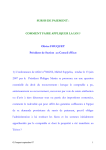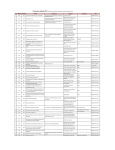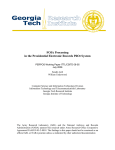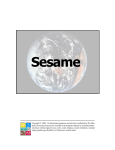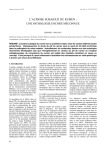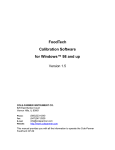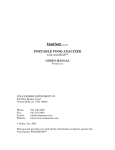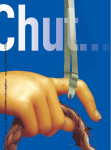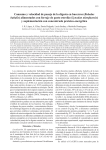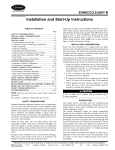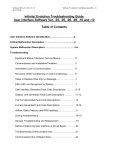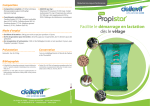Download TROUBLESHOOTING TRANSITION DIETS FOR THE
Transcript
TROUBLESHOOTING TRANSITION DIETS FOR THE DAIRY COW J. P. Goff and R. L. Horst United States Department of Agriculture Agricultural Research Service National Animal Disease Center. Ames, Iowa 50010 Three basic physiologic functions must be maintained during the periparturient period, before and after calving, if disease is to be avoided. These are: 1. Meeting the energy demands of lactation. This will involve adaptation of the rumen – a rumen that is unadapted cannot handle high-energy feeds in early lactation without risk of rumen acidosis. It also involves enhancing total feed (and, therefore, energy) intake. 2. Maintenance of normal blood calcium levels. This includes not only preventing milk fever, but attempting to avoid subclinical hypocalcemia. 3. Reducing the degree of immunosuppression that occurs around calving. In virtually all species examined, the maternal immune system is depressed. To some degree this is caused by the hormone changes associated with calving. However, stress and poor nutrition will increase the degree and length of time the animals are immune-suppressed. If we focus on the first 2 goals and improve energy and calcium status of the animal, the immune system will also benefit. In addition, data now suggest that retained placenta may be a disease caused by reduced immune cell function. MEETING THE ENERGY DEMANDS OF LACTATION Ketosis is diagnosed whenever there are elevated levels of ketones in the blood, urine, or milk of a cow. The disease is always characterized by a decline in blood glucose as well. In lactation, the amount of energy required for maintenance of body tissues and milk production exceeds the amount of energy the cow can obtain from her diet, especially in early lactation when dry matter intake is still low. As a result, the cow must utilize body fat as a source of energy. Every good cow will utilize body reserves in early lactation to help her make milk. However, there is a limit to the amount of fatty acid that can be handled and used for energy by the liver (and to some extent the other tissues of the body). When this limit is reached, the fats are no longer burned for energy but begin to accumulate within the liver cells as triglyceride. Some of the fatty acids are converted to ketones. The appearance of these ketones in the blood, milk, and urine is diagnostic of ketosis. As fat accumulates in the liver it reduces liver function - and a major function of the liver in the dairy cow is to produce glucose. Recent work (Grummer, 1993) demonstrates the importance of feed intake at calving on the etiology of the fatty liver-ketosis syndrome. On average, dry matter intake decreases by 20-30% 1 or 2 days before calving, and does not recover until 1 to 2 days after calving (Bertics et al., 1992; Marquardt et al., 1977). Interestingly, liver biopsies showed that liver triglycerides were increased 3-fold by the day of calving. Triglyceride buildup in the liver is a much earlier phenomena than previously assumed. Even more interesting, when cows were fitted with rumen fistulas and dry matter intake was not allowed to drop around the time of calving by forcing feed into the rumen, liver lipids and triglycerides increased only a small amount. Similar results were also achieved by daily drenching of cows with propylene glycol (1 L/d) during the week before and after calving (Studer et al., 1993). The conclusion is that energy intake must not be compromised during the days around calving. Any factor restricting feed intake around calving (such as milk fever or retained placenta) increases fat accumulation in the liver and affecting the energy deficit of the cow increasing the risk of fatty liver-ketosis. Strategies for Prevention of Negative Energy Balance and Ketosis Control body condition of cows -- Cows should calve with a body condition score (BCS) of 3.25 - 3.75. Cows with BCS of 3.25 will eat better than cows with BCS of 3.75. However, a 3.75 BCS cow that is well managed could potentially produce more milk. What can you do with those fat heifers or dry cows that are overweight? With very careful management it is possible to place these animals on a poorly digestible diet (straw plus trace minerals and a little soymeal to get Nel between 0.9 and 1.1 Mcal/kg and about 11% crude protein) at dry off to drop body condition scores, then place cows on the herd close-up ration for the 2-3 wks before calving. The idea is to create a hungry cow that will go ahead and eat well once she calves. This strategy requires accurate due dates! Trying to reduce weight in the last 3 weeks of pregnancy will mobilize body fat and nearly guarantee fatty liver development! THIS STRATEGY WILL REDUCE FRAME GROWTH IN THE HEIFERS. Adapting the rumen to handle high-energy diets -- Two factors protect the mid-lactation cow from rumen acidosis. The microbes in her rumen are acclimated to high starch diets allowing bacterial species that break down lactic acid to grow. It appears to take about 3 weeks (34) to build up a rumen population of bugs capable of handling starches – hence, a common recommendation to bring cows onto a close-up ration 3 weeks before calving. The rumen wall of the mid-lactation cow has long, wide papillae projecting into the rumen fluid. This increases the surface area of the rumen wall and allows for more rapid transfer of the volatile fatty acids produced during fermentation of feedstuffs into the blood for transport to the liver and other tissues. One study suggested that as much as 50% of the absorptive area may be lost during the first 7 weeks of the dry period (Dirksen et al., 1985). And in this study it took nearly 5 weeks of exposure to high grain diets to restore rumen papillae length. Observations from our laboratory (Goff et al., 2001, unpublished) suggest that cows fed typical U.S. rations do not suffer such a large decline in rumen papillae length – probably because our far off dry cow rations tend to incorporate at least some starch (corn silage) so rumen papillae length does not decline as much. Therefore, 3 weeks in the close-up pen should be adequate for cows. However, heifers do seem to benefit (socially and from a nutritional standpoint) from a longer period of time (5 weeks) on the close-up ration. Cows carrying twins should also enter the close-up pen 5 weeks before expected calving date. They need the extra calories and they usually calve 2 weeks early! Remember, too, that the standard deviation for calving date is ± 9 days; thus, to ensure that 95% of cows in a herd will be on a pre-fresh ration for at least 2 weeks before freshening means that cows in the herd should be started on pre-fresh rations 23 days before their due date. High starch rations in the close-up pen -- The majority of studies that have compared the effects of low starch close-up rations (high forage) with high starch close-up rations have concluded that the number of calories consumed both pre-fresh and post-fresh is increased, largely because dry matter intake is increased. The amount of body fat mobilized (as assessed by monitoring blood NEFA and liver fat accumulation) is also generally decreased, a reflection of the improved energy status of the cow. Starches are converted to propionate in the rumen of the cow. Propionate is the major precursor for making glucose in the liver. Most of the structural carbohydrates in forages are going to be converted to acetate – good for milk fat support but the cow cannot use acetate to make glucose. How high can we push the NFC (roughly equivalent to the starch content in most cases) in the pre-calving and post-calving diet? Most nutrition guidelines would suggest that NFC for close-up rations be kept between 33 and 38% of the ration. A recent study by Minor et al. (1998) utilized close-up rations that were 43.8% NFC as compared to a close-up ration of just 23.5% NFC. Dry matter intake pre-calving was elevated from 10.2 kg/d to 13 kg/d by increasing the starch content of the ration. The cows fed the high NFC rations pre- and post-calving had about a 5 lb increase in milk production/day as well. Because the animals were adapted to the higher starch pre-calving, the cows could be safely moved to a post-calving ration that was 46.5% NFC without suffering rumen acidosis and laminitis. In contrast, changing from a pre-fresh ration that was 23.5% NFC to a post-calving ration that was 41.7% NFC resulted in greater laminitis. This points out that the changes in energy content must not be drastic. Cows can handle high starch rations but it takes time to step them up to the hotter rations. Increasing starch concentration of the pre-calving ration is not likely to cause rumen acidosis in the pre-calving cow because of the overall low intakes of the dry cow. However, putting more starch in generally means you have reduced the fiber (NDF) content of the ration and this is where the problem lies, as it can increase the susceptibility of the herd to displacement of the abomasum. The key is to feed a forage that supplies adequate effective fiber (i.e., particles that are greater than 1.5 inches long that help form a mat on top of the rumen fluids), and is not so long or so unpalatable that it is sorted out by the cows. This often means chopping the forages going into the TMR and adjusting moisture content (a good target is 55-60% dry matter) so sorting is less likely. In some cases, the addition of good clean straw can supply good effective fiber while allowing room in the ration for the added starch in both the pre-calving and postcalving rations. Alfalfa haylages, by and large very palatable, may not supply enough effective fiber to form a good rumen mat and it is this mat that is critical to prevention of left displaced abomasum. Corn silage chopped with less than 1/2 inch theoretical length of cut also does not contribute greatly to formation of the rumen mat. Close-up rations should contain from 35-38% NFC. The total NDF should be a minimum of 33%, and preferably at least 26% forage NDF. The immediate post-calving ration can then safely be increased to 40-42% NFC. Keep NDF of the fresh cow diet above 27% and forage NDF at least 21% of the ration. However, there are other recommendations suggesting that close-up rations should contain from 38-42% NFC. The total NDF should be a minimum of 30% and preferably maintain at least 26% forage NDF. The immediate post-calving ration can then be increased to 44% NFC. Again, keep NDF of the fresh cow diet above 27% and forage NDF at least 21% of the ration. It is absolutely essential that forages be eaten and not sorted from this type of diet strategy in both the close-up and fresh cow pens. It may be necessary to add chopped straw or grass hay to these rations to ensure adequate effective fiber. Adding fat to pre-fresh and post-fresh rations to “spare” the body’s glucose -- The idea behind this strategy is that muscle and other body tissues can burn diet fat for energy instead of blood glucose. Unfortunately, most studies find no benefit and perhaps some increase in nonesterified fatty acid content of blood when fat (both rumen protected or unprotected have been examined) is added to the close-up diet (Skaar et al., 1989). Studies done with cows in early lactation also are not encouraging as the added fat generally has the effect of reducing feed intake in early lactation (Salfer et al., 1995). Once animals are eating well, adding limited amounts of fat to the ration generally increases milk production and improves body condition. Therefore, supplemental fats should not be added until after 2-3 weeks into lactation. Increasing dietary protein in transition and fresh cow rations – The fresh cow loses significant amounts (60–80 lb) of muscle in the first weeks of lactation. She is primarily using the amino acids in her muscle to produce glucose. This strategy suggests that by feeding a high protein ration before calving we can build-up muscle reserves that the cow can draw on in early lactation to help her make glucose. Several studies were done suggesting less ketosis and less loss of body condition when dietary protein of the close-up ration was increased to 16-17% crude protein with 38-44% of the protein being rumen bypass protein (Van Saun, et al., 1993; Holtenius et al., 1993; Vandehaar et al., 1999). Some of these studies were complicated by changes in energy along with protein in the “high protein” diet treatments. Unfortunately, a review of the recent literature does not support increasing diet protein (either as rumen bypass or even as essential amino acids) in pre-fresh rations as a means of improving health or milk production. Most studies suggest there is no gain made by increasing diet crude protein or rumen undegradable protein in close-up rations, and a few studies suggest that high protein diets are even detrimental to the cows (Putnam et al., 1999; Greenfield et al., 2000). So how much protein do we feed the close-up cows? Santos and colleagues (2000) did a nice study to try to answer this question. They fed two levels of dietary protein, 12.7 or 14.7%, to heifers and cows for the 3 weeks prior to calving. These diets were 36 and 40% rumen undegradable protein, respectively. Increasing protein in the close-up diet had no effect on milk production, blood glucose, postpartum body condition score, colostrum immunoglobulin content, or days to first corpus luteum formation in the cows. However, heifers responded to the higher dietary protein in the close-up pen with greater milk production (6.6 lb/d on average). However, blood glucose, post-partum body condition score, colostrum immunoglobulin content, and days to first corpus luteum formation were not improved by the high protein diet. Cows need 12-13% protein close-up rations. Heifers need 15% crude protein close-up rations. Mix of heifers and cows in the close-up pen? Feed 15% crude protein. Most diets fed pre-partum will have plenty of rumen undegradable protein to meet the metabolizable protein needs of the close-up cows and heifers, so it is not a major concern to use bypass protein. In fact, animal sources of bypass protein (blood or fish meal) may reduce feed intake of the dry cow. When only one ration is fed to lactating cows, that ration is generally formulated based on the higher intakes of cows at mid-lactation, and rations containing around 16.5-17% protein will meet the protein requirements for milk production. However, studies demonstrate time and again that the low dry matter intake of the fresh cow will dictate that the amount of protein leaving the body as milk will exceed the amount she will obtain from a 17% protein diet. So, in addition to using body muscle to meet energy needs in early lactation, she must also use body muscle to meet the protein needs of milk production. If you are willing to formulate a special diet for fresh cows (first 2 weeks of lactation), should the protein content of that ration be increased? Some early studies that attempted to improve protein balance in the fresh cow by increasing diet protein utilizing soymeal and alfalfa as sources of protein failed to improve protein balance. Unfortunately, the protein in these feedstuffs is mostly rumen degradable. The rumen bugs have only a limited capacity to utilize the ammonia freed up during rumen digestion. Once that is exceeded, the rest of the rumen degradable protein is wasted and useless to the cow. A few recent studies have suggested that adding rumen undegradable protein or adding certain essential rumen bypass amino acids to the fresh cow ration could benefit the cow and result in higher milk production (Blauwiekel et al., 1997; Khorasani et al., 1996; Armentano et al., 1993; Volden, 1999; Iwanska et al., 1999; Garcia-Bojalil et al., 1998; McCormick et al., 1999). However, not all studies show a response. In a well-done study by Palmquist and Weiss (1994), blood meal was added to provide a good source of rumen bypass protein to fresh cows with no benefit. However, in this study adding blood meal reduced feed intake. It is, therefore, critical that the rumen bypass or amino acid supplements not reduce feed intake. What is the problem with feeding excess protein? There are certainly environmental issues associated with feeding excess nitrogen to the cow. But it can also be detrimental to the cow in that excess nitrogen absorbed from the diet must be excreted from the body by coupling 2 nitrogen atoms to a carbon atom to form urea. Unfortunately, that carbon comes from a carbohydrate source (i.e., the cow is burning up glucose to get rid of nitrogen). While not a huge energy cost overall, it should be avoided when possible. For example, a dry cow getting 17% crude protein when she only needs 12% will have to consume approximately 3/4 lb extra feed to supply the energy needed to get rid of that extra nitrogen. A safe recommendation would be to feed 17-18% crude protein in the fresh cow with 10.5 % of the ration being rumen degradable protein and the rest bypass protein. Add niacin -- Thought to reduce mobilization of body fat to reduce non-esterified fatty acid in blood and reduce the fat load to the liver. May also stimulate feed intake. Feed at 6-12 g/cow/day, at $.06 -.12 cents/day. Research on this is equivocal. Niacin would probably be a good investment only if cows are overconditioned and you anticipate fatty liver. Calcium or sodium propionate, glycerol or propylene glycol added to the ration -- The idea is to provide the cow with propionate (glycerol and propylene glycol will be metabolized to glucose also) that can be readily converted to glucose by the liver. Oral administration of propionate salts, glycerol or propylene glycol is unquestionably an effective means of treating ketosis. Sodium propionate should not be used in pre-fresh rations because it will raise diet DCAD and cause milk fever. Calcium propionate or propylene glycol (300 ml/day) can be added to pre-fresh rations. Glycerol may work in this capacity as well but has yet to be tested extensively. The best use of calcium propionate, glycerol, and propylene glycol may be as bolus drenches or pastes administered in the day or two immediately around calving time. Bolus dosing of 1.5 lb of calcium propionate or 1.5 liters of glycerol or 300 ml of propylene glycol results in rapid increases in blood glucose (and subsequently insulin) which reduces blood nonesterified fatty acid levels in the blood. Add yeast products and direct fed microbials – The idea is to help improve fiber digestion and improve lactic acid utilization in the rumen. Responses can be variable and each company has its own line of products, making assessment difficult. Independent research is still required to make a recommendation on their use. Cost will be between $.03 and $.18/day. New variants on this theme are being researched with some promising results (Dann et al., 2000; Rode et al., 1999). Try one of those with at least some university research behind it. Use it in both the closeup and fresh cow rations and evaluate whether you are seeing a response on your farm. The response in many herds is good. Others have no response. Administer bovine somatotrophin (bST) -- Anecdotal evidence is emerging that cows treated with bST prepartum suffer less ketosis. The theory is that bST stimulates glucose production and increases efficiency of fat utilization. However, research support for this is still sketchy and as it is off-label use of bST, it cannot be recommended. Treatment of ketosis -- Intravenous glucose should remain the backbone of treatment regimens for ketosis. While one-time treatment is often all that is required to successfully treat lactation ketosis (providing diet is adjusted), repeated treatments are usually necessary to treat peri-parturient ketosis. Glucocorticoids (dexamethasone and isoflupredone acetate) given ONCE can be useful. They may stimulate glucose production within the liver. They also may improve appetite. They also can reduce milk production temporarily, which improves the energy balance of the cow. However, dexamethasone tends to suppress the immune system, while repeated or large, off-label doses of isoflupredone acetate can upset electrolyte balance in the cow causing very low blood potassium levels and down cows. A few reports suggest that giving cows insulin at the same time they are receiving IV glucose enhances the therapeutic effect of the glucose (Sakai et al., 1993). This approach is probably not a dramatic improvement over the standard therapy and poses a potential threat to the cow by inducing a low blood glucose coma if the wrong type of insulin is used. Only the short acting insulins should be used, and it turns out those products have essentially been removed from the market. PREVENTION OF HYPOCALCEMIA AND MILK FEVER Hypocalcemia (low blood calcium, not just milk fever) impairs abomasal contractions leading to more displaced abomasum, prevents the teat sphincter from closing after milking, allowing bacteria access to the mammary gland, and the stress of hypocalcemia causes secretion of cortisol, which further impairs the immune system of the fresh cow. Milk fever and low blood calcium reduce feed intake, increasing the risk of ketosis in the cow as well. We now believe that hypocalcemia occurs because the dairy cow is in an alkaline blood condition, largely because of the high potassium content of the forages utilized in close-up cow rations. A second major cause of hypocalcemia is inadequate magnesium absorption from the close-up and fresh cow rations leading to low blood magnesium concentration. We believe that when blood magnesium is marginally low it interferes with the body’s ability to regulate blood calcium concentration. Steps to Reduce the Impact of Hypocalcemia in a Herd Close-up rations -- The major culprit causing low blood calcium is high potassium coming into the ration from forages. Sodium is also very bad, but generally is not very high in forages. FIND OR GROW LOW POTASSIUM FORAGES FOR YOUR CLOSE-UP DRY COWS. Limit potash and manure applications. Rely on corn silage as a major feedstuff for close-up cows. It is palatable, and usually low in potassium. Some byproduct feeds should also be considered such as beet pulp without molasses. DO NOT TRUST POTASSIUM VALUES DETERMINED BY NEAR INFRARED ANALYSIS. Do a wet chemistry analyses. Bring magnesium content of close-up rations to 0.4% using a combination of magnesium sulfate and magnesium oxide. To check to see if your herd is absorbing adequate magnesium – a blood sample taken from a cow within 12 hr after calving should contain at least 2.0 mg magnesium/dl. Feed 40 g phosphorus/day and bring diet calcium to 1% in the close-up ration. The above steps, provided you succeed in limiting potassium to less than 1.6% of the ration, will nearly eliminate milk fever (blood calcium less than 5 mg/dl which causes cows to lose muscle function) in Holstein herds. To get better control of blood calcium it will be necessary to add anions (chloride and sulfate) to the ration of 2nd lactation or greater cows to help acidify the cow’s blood and urine before calving. Traditionally, this was done by adding anionic salts such as ammonium chloride, calcium chloride, or magnesium sulfate to the ration. Unfortunately, these salts often reduced feed intake in cows causing more problems than it was curing. We believe that chloride is a more effective acidifier than sulfate anions. We also have demonstrated that hydrochloric acid is a more effective acidifying agent than the traditional anionic salts and also appears to be more palatable. Several commercial firms are now producing anion supplements that are based on hydrochloric acid. We do not recommend attempting to mix rations using liquid hydrochloric acid on the dairy. Hydrochloric acid creates fumes that are toxic and corrosive, making it very unsafe to use on dairies. Leave the addition of this ingredient to professionals who are equipped to deal with these issues. How do you know how much anion to add? Bringing the diet cation-anion difference, (sodium + potassium) – (chloride + sulfur), expressed as mEq/kg, to zero is a good place to start. After a few days on that ration, evaluate urine pH of the close-up cows (6-8 cows is a good sample size). Samples should be caught cleanly and should be mid-stream collections. Urine pH of Holstein cows in the week before calving should be 6.2-6.8. The target for Jerseys is 5.8-6.3. If above the target pH then more anion is needed in the ration. If urine pH is below 5.8 you have over-acidified the cows and they may crash unless you reduce the anions in the ration! Anionic should not be used unless there is a willingness to monitor urine pH!! When using traditional anionic salts, calcium can be brought into the ration in the form of calcium chloride and magnesium can be brought in as magnesium sulfate. When using hydrochloric acid as my anion source (which I really prefer, a bias I admit as these type of products are based on my own research), I generally use a small amount of magnesium sulfate (50–75 g /day) to get a soluble magnesium source into the ration and then use calcium carbonate and magnesium oxide to reach my targets of 1% calcium and 0.4% magnesium. Heifers do not need anionic salts. They may perform more poorly as a result of reduced feed intake. Again, this is more of a problem when the unpalatable anionic salts are used. Ideally, heifers would be fed separately from older cows – they perform better on higher protein diets, without anions, and when housed separately do not have to compete with cows for bunkspace. Heifers do respond to the lower potassium diets with less udder edema. When chloride is utilized as an anion source, it has a diuretic effect which can decrease udder edema in some herds. However, this may not be true when ammonium chloride salts are used. Cow “pumping”, drenching and pasting -- A number of products are available to boost blood calcium and prevent ketosis in cows. Soluble sources of calcium (calcium chloride and calcium propionate) are used to increase blood calcium for about 6-10 hr after dosing. Some products incorporate propylene glycol and propionate as energy sources for the fresh cow. These commercial products are handy, and the thicker pastes available in a caulking gun type delivery tend to be easy to administer and relatively safe in that the cow will not breathe them into her lungs very easily. With the advent of the esophageal pumping systems, many producers are trying to combat the decline in feed intake at calving by administering fluids, calcium, and energy supplements to the cow at calving (and sometimes again 24 hr after calving). These homemade cocktails can be inexpensive ($2-4/treatment). Very little research has been done to prove the value of these cocktails administered to the fresh cow. Our own research suggests that herds that are on a good plane of nutrition and well-transitioned do not benefit noticeably from any of these treatments. However, they are helpful in herds that are suffering from higher rates of metabolic disease. Best results are obtained when the dose is given at calving and again 24 hr after calving. A cocktail for fresh cows that is to be delivered by esophageal pump should contain: 1) A source of calcium, which we think should be calcium propionate. 1.5 lbs is a good dose for Holsteins. 2) A source of energy. Again, calcium propionate is a good choice. The 1.5 lb dose supplies a good amount of glucose precursors to the cow. One can also add 0.5 L (1/2 quart) propylene glycol or 1 quart of glycerol. 3) Electrolytes – 100–150 g potassium chloride is a good dose to help restore body fluids lost after calving. 4) A source of magnesium. 200 g magnesium sulfate works well in our hands. 5) OPTIONAL FOR THOSE FARMS WITH DOWNER COW PROBLEMS DIAGNOSED BY VET AS LOW BLOOD PHOSPHORUS DOWNERS. Give cows 200 g monosodium phosphate. 6) OTHER OPTIONS – Some people choose to add 2-3 lbs of finely ground alfalfa meal to the cocktail to get the rumen going. Mix all or parts of the above recipe in 3-5 gallons warm water and pump into the cow. Be aware that the cocktail should be delivered slowly and INTO THE ESOPHAGUS if you are to avoid drowning cows!! MAINTAINING THE BEST IMMUNE SYSTEM POSSIBLE IN THE FRESH COW The biggest culprit affecting the immune system are the hormone changes associated with calving and the negative energy and protein balances of cows in early lactation. The energy and protein imbalances are not easily fixed, and this is why the first part of this paper has spent so much time discussing ways to improve the status of these two nutrients. Deficiencies of any of the micronutrients will result in immune function loss as well. To that end, the following guidelines are utilized by me to prevent the short-term deficiencies in vitamins and minerals we sometimes see in dairy cattle. Feed 2000 IU vitamin E/day for the 2-3 weeks before calving and the first 2 weeks of lactation. Feed 0.3 mg/kg selenium, the legal limit. Add trace minerals in adequate amounts. Farms should get in the routine habit of assessing the adequacy of their trace mineral program by harvesting liver, once or twice each year, from a cow that has died rapidly due to trauma, lightning, etc., or is going to slaughter. The liver sample should be analyzed for trace mineral content. Liver is the best indicator of the status of copper, zinc and manganese supplementation. Blood is generally unreliable. Dietary iron greater than 800 mg/kg diet and water iron greater than 0.5-2.0 mg/kg is too much. We think this causes oxidative stress in animals and reduces immune cell function. Recently, we have been able to confirm some earlier studies that suggest that retained placenta is a disease that involves the immune system (Gunnink, 1984). We believe that the fetal tissues comprising the placenta have to be recognized by the mother’s white blood cells as foreign and “rejected” by the mother in order to get release of the fetal membranes from the mother’s uterus at calving. We find that those cows with reduced immune cell function at calving fail to recognize placental tissue and attack it in our assays and that those cows are the cows that go on to develop a retained placenta. REFERENCES Armentano, L. E., S. M. Swain, G. A. Ducharme. 1993. Lactation response to ruminally protected methionine and lysine at two amounts of ruminally available nitrogen. J. Dairy Sci. 76:2963-2969. Bertics, S. J., R. R. Grummer, C. Cadorniga-Valino, D. W. LaCount, E. E. Stoddard. 1992. Effect of prepartum dry matter intake on liver triglyceride concentration and early postpartum lactation. J. Dairy Sci. 75:1914-1922. Blauwiekel, R., S. Xu, J. H. Harrison, K. A. Loney, R. E. Riley, M. C. Calhoun. 1997. Effect of whole cottonseed, gossypol, and ruminally protected lysine supplementation on milk yield and composition. J. Dairy Sci. 80:1358-1365. Dann, H. M., J. K. Drackley, G. C. McCoy, M. F. Hutjens, J. E. Garrett. 2000. Effects of yeast culture (Saccharomyces cerevisiae) on prepartum intake and postpartum intake and milk production of Jersey cows. J. Dairy Sci. 83:123-127. Dirksen, G. U., H. G. Liebich, and E. Mayer. 1985. Adaptive changes of the ruminal mucosa and their functional and clinical significance. Bovine Pract. 20:116-120. Garcia-Bojalil, C. M., C. R. Staples, C. A. Risco, J. D. Savio, W. W. Thatcher. 1998. Protein degradability and calcium salts of long-chain fatty acids in the diets of lactating dairy cows: productive responses. J. Dairy Sci. 81(5):1374-1384. Greenfield, R. B., M. J. Cecava, T. R. Johnson, S. S. Donkin. 2000. Impact of dietary protein amount and rumen undegradability on intake, peripartum liver triglyceride, plasma metabolites, and milk production in transition dairy cattle. J. Dairy Sci. 83:703-710. Grummer, R. R. 1993. Etiology of lipid related disorders in periparturient dairy cows. J. Dairy Sci. 76:3882-3896. Gunnink, J. W. 1984. Pre-partum leucocytic activity and retained placenta. Vet. Quart. 6:52-54. Holtenius, P., G. Olsson, C. Bjorkman. 1993. Periparturient concentrations of insulin glucagon and ketone bodies in dairy cows fed two different levels of nutrition and varying concentrate/roughage ratios. Zentralbl Veterinarmed A., 40(2):118-127. Iwanska, S., D. Strusinska, B. Pysera. 1999. Effect of rumen protected methionine supplementation on early lactational responses of dairy cows fed a grass silage and cereals diet. Acta Vet. Hung. 47:191-206. Khorasani, G. R., G. De Boer, J. J. Kennelly. 1996. Response of early lactation cows to ruminally undegradable protein in the diet. J. Dairy Sci. 79:446-453. Marquardt, J. P., R. L. Horst, and N. A. Jorgensen. 1977. Effect of parity on dry matter intake at parturition in dairy cattle. J. Dairy Sci. 60:929-934. McCormick, M. E., D. D. French, T. F. Brown, G. J. Cuomo, A. M. Chapa, J. M. Fernandez, J. F. Beatty, D. C. Blouin. 1999. Crude protein and rumen undegradable protein effects on reproduction and lactation performance of Holstein cows. J. Dairy Sci. 82:2697-2708. Minor, D. J., S. L. Trower, B. D. Strang, R. D. Shaver, R. R. Grummer. 1998. Effects of nonfiber carbohydrate and niacin on periparturient metabolic status and lactation of dairy cows. J. Dairy Sci. 81:189-200. Palmquist, D. L., W. P. Weiss. 1994. Blood and hydrolyzed feather meals as sources of undegradable protein in high fat diets for cows in early lactation. J. Dairy Sci. 77:1630-1643. Putnam, D. E., G. A. Varga, H. M. Dann. 1999. Metabolic and production responses to dietary protein and exogenous somatotropin in late gestation dairy cows. J. Dairy Sci. 82:982-995. Rode, L. M., W. Z. Yang, K. A. Beauchemin. 1999. Fibrolytic enzyme supplements for dairy cows in early lactation. J. Dairy Sci. 82:2121-2126. Sakai ,T. T. Hayakawa, M. Hamakawa, K. Ogura, S. Kubo. 1993. Therapeutic effects of simultaneous use of glucose and insulin in ketotic dairy cows. J. Dairy Sci. 76:109-114. Salfer, J. A., J. G. Linn, D. E. Otterby, W. P. Hansen, D. G. Johnson. 1995. Early lactation responses of Holstein cows fed a rumen-inert fat prepartum, postpartum, or both. J. Dairy Sci. 78(2):368-377. Santos, J. P., E. J. DePeters, P. W. Jardon, and J. T. Huber. 2001. Effect of prepartum dietary protein level on performance of primigravid and mutiparous Holstein dairy cows. J. Dairy Sci. 84:213-224. Skaar, T. C., R. R. Grummer, M. R. Dentine, R. H. Stauffacher. 1989. Seasonal effects of prepartum and postpartum fat and niacin feeding on lactation performance and lipid metabolism. J. Dairy Sci. 72(8):2028-2038. Studer, V. A., R. R. Grummer, S. J. Bertics, C. K. Reynolds. 1993. Effect of prepartum propylene glycol administration on periparturient fatty liver in dairy cows. J. Dairy Sci. 76:29312939. Vandehaar, M. J., G. Yousif, B. K. Sharma, T. H. Herdt, R. S. Emery, M. S. Allen, J. S. Liesman. 1999. Effect of energy and protein density of prepartum diets on fat and protein metabolism of dairy cattle in the periparturient period J. Dairy Sci. 82:1282-1295. Van Saun ,R. J., S. C. Idleman, C. J. Sniffen. 1993. Effect of undegradable protein amount fed prepartum on postpartum production in first lactation Holstein cows. J. Dairy Sci. 76:236-244. Volden, H. 1999. Effects of level of feeding and ruminally undegraded protein on ruminal bacterial protein synthesis, escape of dietary protein, intestinal amino acid profile, and performance of dairy cows. J. Anim. Sci. 77:1905-1918. Young, J. W., J. J. Veenhuizen, J. K. Drackley, and T. R. Smith. 1990. New insights into lactation ketosis and fatty liver. Page 60 in 1990 Cornell Nutrition Conference, Ithaca, NY.












